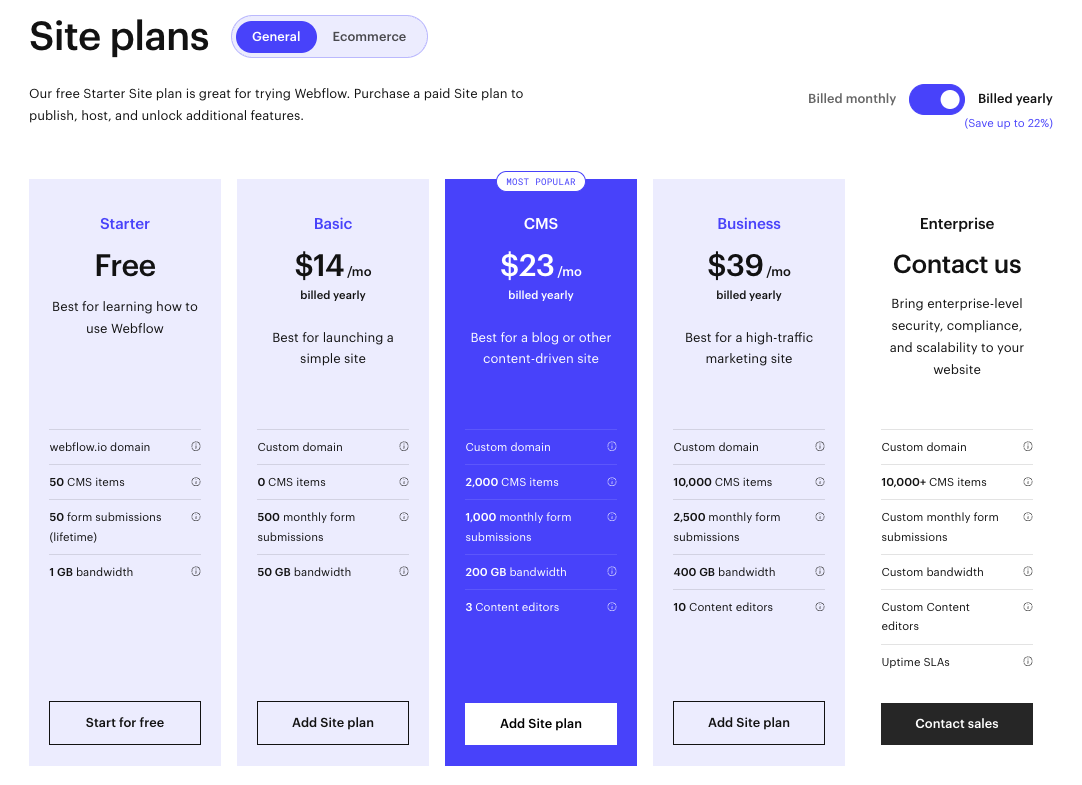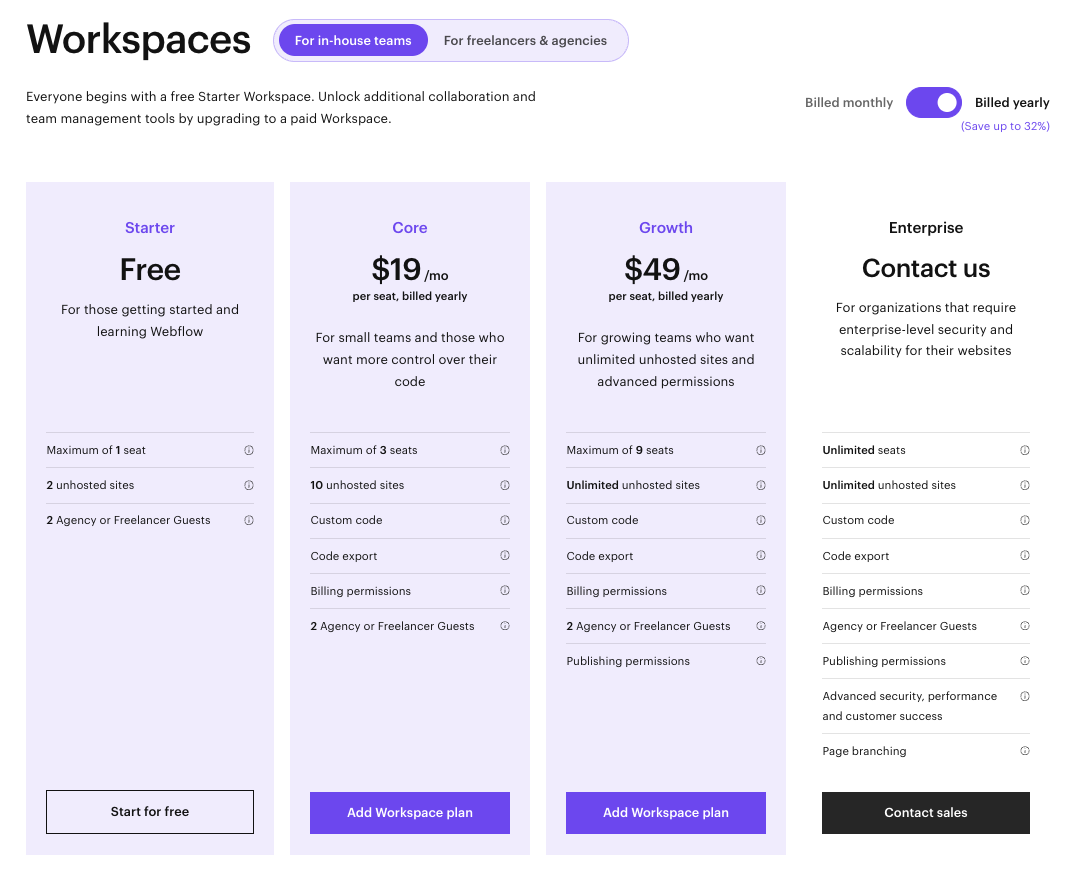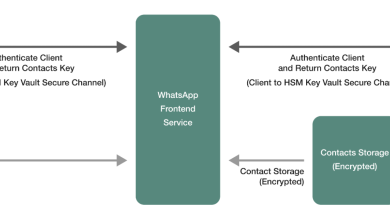How Much Does Webflow Cost In 2024?

So you want to build your own eye-catching website – for a blog, a business site, or an e-commerce shop. You’ve heard of Webflow as a good, no-code visual web design tool for this. But how much does Webflow really cost?
This guide explains Webflow’s different plans and pricing, our recommended plans for your different website needs, and how Webflow pricing plans compare with the top three most popular site builders’ pricing.
Read on to learn more.
Webflow Pricing Plans
Although Webflow has 15 different plans and pricing on its website, these can be categorized into three main types of plans: Site, E-commerce, and Workspace Plans.
All Webflow Plans include 100 static pages, automatic data backups, security features, and immediate scaling capabilities.
Site Plans

Site Plans cover Starter, Basic, CMS, Business, and Enterprise Plans.
Starter Plan
This is the Webflow free plan, with a Webflow.io domain instead of your own custom domain. This is best for learning how to use Webflow.
You can have a maximum of 50 content management system (CMS) items that you can use in a CMS database. CMS items are where all the dynamic content of your website are stored. You have a one-gigabyte (1GB) content delivery network (CDN) bandwidth every month. Webflow notifies you when you exceed this limit.
Basic Plan
This Webflow plan costs $14 monthly if you choose the annual billing option or $18 monthly if you choose the monthly billing option.
Like the Starter Plan, it has all the necessary features to build a simple and operational website. One difference is its custom domain feature. You don’t have to use a Webflow.io domain, and you can buy a domain through Webflow. However, this plan offers no CMS items, although it offers 50 GB of CDN bandwidth every month.
CMS Plan
This Webflow plan costs $23 monthly if you choose the annual billing option or $29 monthly if you choose the monthly billing option.
This is best if you want to build a content-driven website or start a blog. You can explore how to blog on Webflow and choose this plan for a cost-effective solution. It offers 2,000 CMS items and a 200-GB monthly CDN bandwidth. You can add up to three guest editors to access and edit content in the Webflow Editor with this plan.
Business Plan
This Webflow plan costs $39 monthly if you select the annual billing option or $49 monthly if you pick the monthly billing option.
This is best for high-traffic marketing websites. You can create custom domains and add up to 10 guest editors to access and edit content in the Webflow Editor. You can add up to 10,000 CMS items on a 400-GB monthly CDN bandwidth.
Enterprise Plan
Contact Webflow for custom pricing depending on your business needs.
With enterprise-level security, compliance, and scalability, this plan offers custom domain and bandwidth features.
Depending on your business requirements, you can also customize guest editors to optimize using the Webflow Editor. This plan also includes uptime Service Level Agreements (SLAs), which are commitments between the service provider and client on the level of service to be provided while it is in operation.
E-commerce Plans

E-commerce Plans come in Standard, Plus, and Advanced Plans. If your main goal is to build e-commerce websites, this is the plan for you. Webflow e-commerce pricing per sub-plan is detailed below.
Standard Plan
This Webflow plan costs $29 monthly if you choose the annual billing option or $42 monthly if you choose the monthly billing option.
Best for small businesses, this plan includes 500 items such as CMS items and e-commerce products, variants, and categories. For a maximum of $50K annual sales volume, Webflow charges a 2% transaction fee on top of PayPal and Stripe fees.
Plus Plan
This Webflow plan costs $74 monthly if you pick the annual billing option or $84 monthly if you select the monthly billing option.
Best for over-$5K up to $200K annual sales volume businesses, this plan does not charge a Webflow transaction fee.
It includes all Business Plan features where you can create custom domains and add up to 10 guest editors to access and edit content in the Webflow Editor. You can also add up to 10,000 CMS items on a 400-GB monthly CDN bandwidth.
Advanced Plan
This Webflow plan costs $212 monthly if you choose the annual billing option or $235 monthly if you choose the monthly billing option.
With this plan, you can include up to 3,000 items. It has unlimited annual sales volume capacity with no Webflow transaction fees. It includes all Business Plan features as well.
Workspace Plans
Workspace Plans are divided into two user categories: for Freelancers and Agencies and for In-House Teams.
These Plans let you assign roles to team members and give permissions. They are ideal for intensive collaborative work on your website. If you have non-hosted sites with site limits, the Workspace Plan allows you to increase your site limits.
Freelancers and Agencies

These plans are best for freelancers and agencies collaborating with their clients.
Starter Plan
This Webflow free plan with limited features is best for freelancers. Only one seat can use this plan, though. You can build up to two unhosted sites on Webflow.io domains.
Freelancer Plan
This Webflow plan costs $16 monthly if you choose the annual billing option or $24 monthly if you choose the monthly billing option.
You can use up to three seats and add up to 10 unhosted sites on Webflow.io domains. This plan allows full CMS access to users on these unhosted sites.
Agencies Plan
This Webflow plan costs $35 monthly if you pick the annual billing option or $42 monthly if you decide on the monthly billing option.
You can use up to nine seats and build unlimited unhosted sites on Webflow.io domains with full CMS access. You can control and manage your team’s publishing permissions.
In-House Teams

These plans are best for in-house teams regularly collaborating with each other to work on your websites.
Starter Plan
A Webflow free plan with limited features, this is best for freelance designers managing multiple projects. Only one seat can use this plan, though. It does not allow for teammates and other collaborators. You can build up to two unhosted sites with this plan.
Core Plan
This Webflow plan costs $19 monthly if you choose the annual billing option or $28 monthly if you choose the monthly billing option.
Best for freelancers and small teams, it allows you to control your code. You can also add custom codes and export Cascading Tile Sheets (CSS) and Hypertext Markup Language (HTML) files to create dynamic content.
Workspace owners and administrators can customize subscriptions and billing information. You can add up to three seats to a workspace. You can also allow up to two agency or freelancer guests access to your workspace.
You can add up to 10 unhosted sites designed on Webflow as non-premium sites.
Growth Plan
This Webflow plan costs $49 monthly if you decide on the annual billing option or $60 monthly if you choose the monthly billing option.
Best for growing teams and agencies, you can add up to nine seats to your workspace in this plan. With unlimited capacity for adding unhosted sites, you can also add custom codes for your websites.
With its clean CSS and HTML file-exporting capability feature, you can create dynamic content. You can also customize publishing permissions for various team members.
Enterprise Plan
Contact Webflow for custom pricing depending on your business requirements.
This Webflow plan offers enterprise-level security, compliance, and scalability. With unlimited hosting and customizable seat limits capability, you can control permissions for publishing content or adding products to your website.
With page branching (multiple designers working on separate pages at the same time), clean CSS and HTML file-exporting capability, and customizable coding, you can create unique dynamic content.
This plan’s advanced security and performance options include features such as single sign-on and the highest-tier support for customer success.
Which Webflow Pricing Plan Is Right For You?
Content-driven websites such as blogs and news websites, or simple but high-traffic marketing websites, should go for any of the Site Plans that fit their needs. Save up to 20% on costs by selecting annual billing.
For building online stores, go for E-commerce Plans and save up to 30% by choosing annual billing.
For heavy collaboration work with freelancers, marketing teams, and agencies managing multiple websites, go for the Workspace Plan, and save up to 32% when you opt for annual billing.
Webflow Pricing vs. Top 3 Alternatives’ Pricing

The top three Webflow alternatives are WordPress, Wix, and Shopify. WordPress is an open-source hosting provider, while Wix and Shopify are Software As A Service (SaaS) hosting providers like Webflow. If you’re exploring options, consider taking the time to compare website builders to ensure you find the best fit for your specific needs and budget.
Webflow vs. WordPress Pricing
Although open-source software is usually free to install, there are several other expenses you have to incur.
For example, hosting and running a WordPress site can cost from $11 to $20 monthly or $132 to $240 annually. However, this does not yet include the additional cost of installing plugins on a WordPress site, which can range from $39 to $800 annually.
Webflow also offers more no-code design freedom than WordPress. You can achieve customization with WordPress, too, but you would need to hire a developer for it. For those requiring more complex, code-based solutions, a Drupal development service presents an alternative, especially for intricate web development projects.
It’s also easier to make design changes to a Webflow site after you’ve built it. You can use classes to style elements such as buttons, headings, and images. Similarly, working with a custom WordPress development company can offer tailored solutions that can reflect more of your unique brand and functionality needs. You can also change spacing, layout, and size, which automatically changes the style of all the elements that use that particular class.
Sure, you can do this with CSS on WordPress, but you can’t do no-code design tweaks unless you add and pay for a visual drag-and-drop design plugin.
Webflow vs. Wix Pricing
On the other hand, SaaS providers usually offer a free trial or free plan for you to test their functionalities and performance. Then, you can upgrade to paid versions once you’re comfortable and satisfied with their features.
Wix plans’ pricing ranges from $4.50 to $24.50 monthly ($54 to $294 annually) for Website Plans and $17 to $35 monthly ($204 to $420 annually) for Business and eCommerce Plans. Wix offers customizable pricing for Enterprise Plans.
Both Wix and Webflow have user-friendly templates that allow drag-and-drop capability without the need for coding knowledge. Unlike Wix, which mainly relies on templates, though, Webflow provides an internal CSS/HTML editor, which lets administrative users dive deep into website customization.
For example, users can create custom interactions and animations based on website user interaction, page scroll, page load, and more variables. Developers can also easily integrate custom code or leverage Webflow’s CMS application programming interface (API).
Wix users can choose from 800 designer-made templates for different types of websites, from recipe blogs to jewelry design to car mechanics and more. The templates are organized into Blog, Business and Services, Community, Creative, and Store.
Webflow allows for full customization for users with no coding knowledge to professional developers. Experienced developers would want to make full use of Webflow’s CSS/HTML capabilities, on-page editing interface, and other advanced features to build custom-designed websites from scratch.
Webflow vs. Shopify Pricing
Shopify plans cost from $19 to $299 monthly or $228 to $3,588 annually. These are not too different from and even higher than Webflow’s, which cost from $14 monthly to $235 monthly or $168 to $2,820 annually.
Although both Shopify and Webflow have a huge library of attractive templates, Webflow has better template designs and customizability, which is important for e-commerce sites. Looks may not be everything, but for e-commerce sites, you want your visitors to stick around to browse and shop from your online store with a user experience (UX)-targeted design.
Shopify has a larger set of e-commerce tools, seamless integration, and features, though, as it was built specifically for e-commerce. Both Shopify and Webflow have the following basic selling tools: abandoned cart recovery, apps, multi-channel selling, point-of-sale (POS) system, products and inventory management, product types, shipping, and staff accounts.
In terms of payment options and transaction fees, Shopify is compatible with more than 100 payment gateways, aside from its own Shopify Payments gateway. If you use Shopify Payments for your online store, you won’t have to pay any transaction fees for processed payments. If you use other gateways, Shopify transaction fees range from 2.4% to 2.9% + 30 cents.
Webflow supports a smaller selection of gateways but still carries the most popular ones, like Apple Pay, PayPal, and Stripe. You’ll need to pay a transaction fee if you’re on the Standard Plan, but no more transaction fees on the Plus or Advanced Plans.
FAQs
Why is Webflow expensive?
With Webflow, you’re not only paying for hosting. You’re also paying for special built-in features you don’t get with other hosting providers, such as additional plugins. It may be expensive, but it’s not more expensive than other SaaS hosting providers.
Is Webflow Worth it?
Webflow helps you build websites more efficiently and complete client work faster, so it’s worth it for successful freelancers and established agencies. If you’re just starting out, it’s not worth purchasing any paid plan. If you’re already established, you can upgrade to a paid plan that fits your needs.
What happens if I stop paying Webflow?
Your plan will be downgraded to the Webflow free Starter Plan. This will immediately remove your custom domains and unpublish your site from its custom domains and the Webflow staging site. The first two unhosted sites that you created with Webflow will remain editable, but any additional sites will be locked.
Is Webflow more expensive than Wix?
Yes, but Webflow has better customization features. Webflow’s plans cost from $14 monthly to $235 monthly, or $168 to $2,820 annually. Wix plans cost from $4.50 to $35 monthly, or $54 o $420 annually.
How long can I use Webflow for free?
Webflow’s free Starter Plans are free forever. However, your website building and hosting needs grow over time if your business scales.



